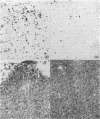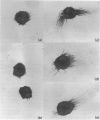Abstract
A single systemic dose of cyclophosphamide (CY) has been shown to enhance cellular immunity in a variety of antigen models. The immunoenhancing effects of CY have been attributed to its ability to selectively abrogate suppressor cell function. Previous studies from our group have demonstrated that local administration of distinct cytostatic drugs at the sensitization site can induce a similar enhancement of delayed-type hypersensitivity as systemic CY, with the obvious advantage of avoiding systemic side-effects. In the present study we investigated the effects of local administration of an optimally immunopotentiating dose of the active CY-derivative Z 7557 and, in selected experiments, of etoposide (VP-16) and systemic CY on mononuclear cells in draining lymph nodes. Whereas CY caused a long-lasting and marked depletion of B-cell areas, locally administered Z 7557 and VP-16 relatively spared B cells and even induced an increase in B- and T-cell numbers in (keyhole limpet haemocyanin-) sensitized mice. At Day 4 the CD4/CD8 ratio was slightly reduced in drug-treated mice. Interestingly, drug treatment reduced the proportion of interdigitating cells staining with the monoclonal antibodies NLDC-145 and MIDC-8. Upon isolation, dendritic cells (DC) from sensitized, Z 7557-treated mice showed longer dendritic protrusions and an enhanced accessory cell function compared to DC from saline-treated controls. These findings suggest that immunoenhancing effects of cytostatic drugs may occur via an effect on DC.
Full text
PDF








Images in this article
Selected References
These references are in PubMed. This may not be the complete list of references from this article.
- Askenase P. W., Hayden B. J., Gershon R. K. Augmentation of delayed-type hypersensitivity by doses of cyclophosphamide which do not affect antibody responses. J Exp Med. 1975 Mar 1;141(3):697–702. doi: 10.1084/jem.141.3.697. [DOI] [PMC free article] [PubMed] [Google Scholar]
- Baadsgaard O., Salvo B., Mannie A., Dass B., Fox D. A., Cooper K. D. In vivo ultraviolet-exposed human epidermal cells activate T suppressor cell pathways that involve CD4+CD45RA+ suppressor-inducer T cells. J Immunol. 1990 Nov 1;145(9):2854–2861. [PubMed] [Google Scholar]
- Bedford P. A., Knight S. C. The effect of retinoids on dendritic cell function. Clin Exp Immunol. 1989 Mar;75(3):481–486. [PMC free article] [PubMed] [Google Scholar]
- Berd D., Mastrangelo M. J. Effect of low dose cyclophosphamide on the immune system of cancer patients: depletion of CD4+, 2H4+ suppressor-inducer T-cells. Cancer Res. 1988 Mar 15;48(6):1671–1675. [PubMed] [Google Scholar]
- Boerrigter G. H., Scheper R. J. Local administration of cytostatic drug 4-hydroperoxy-cyclophosphamide (4-HPCY) facilitates cell-mediated immune reactions. Clin Exp Immunol. 1984 Oct;58(1):161–166. [PMC free article] [PubMed] [Google Scholar]
- Breel M., Mebius R. E., Kraal G. Dendritic cells of the mouse recognized by two monoclonal antibodies. Eur J Immunol. 1987 Nov;17(11):1555–1559. doi: 10.1002/eji.1830171105. [DOI] [PubMed] [Google Scholar]
- Gill H. K., Liew F. Y. Regulation of delayed-type hypersensitivity. III. Effect of cyclophosphamide on the suppressor cells for delayed-type hypersensitivity to sheep erythrocytes in mice. Eur J Immunol. 1978 Mar;8(3):172–176. doi: 10.1002/eji.1830080306. [DOI] [PubMed] [Google Scholar]
- Granstein R. D., Askari M., Whitaker D., Murphy G. F. Epidermal cells in activation of suppressor lymphocytes: further characterization. J Immunol. 1987 Jun 15;138(12):4055–4062. [PubMed] [Google Scholar]
- Greene M. I., Sy M. S., Kripke M., Benacerraf B. Impairment of antigen-presenting cell function by ultraviolet radiation. Proc Natl Acad Sci U S A. 1979 Dec;76(12):6591–6595. doi: 10.1073/pnas.76.12.6591. [DOI] [PMC free article] [PubMed] [Google Scholar]
- Gurish M. F., Lynch D. H., Daynes R. A. Changes in antigen-presenting cell function in the spleen and lymph nodes of ultraviolet-irradiated mice. Transplantation. 1982 Mar;33(3):280–284. doi: 10.1097/00007890-198203000-00014. [DOI] [PubMed] [Google Scholar]
- Halliday G. M., Wood R. C., Muller H. K. Presentation of antigen to suppressor cells by a dimethylbenz (a) anthracene-resistant, Ia-positive, Thy-1-negative, I-J-restricted epidermal cell. Immunology. 1990 Jan;69(1):97–103. [PMC free article] [PubMed] [Google Scholar]
- Katz D. R., Drzymala M., Turton J. A., Hicks R. M., Hunt R., Palmer L., Malkovský M. Regulation of accessory cell function by retinoids in murine immune responses. Br J Exp Pathol. 1987 Jun;68(3):343–350. [PMC free article] [PubMed] [Google Scholar]
- Katz S. I., Parker D., Turk J. L. B-cell suppression of delayed hypersensitivity reactions. Nature. 1974 Oct 11;251(5475):550–551. doi: 10.1038/251550a0. [DOI] [PubMed] [Google Scholar]
- Kaufmann S. H., Hahn H., Diamantstein T. Relative susceptibilities of T cell subsets involved in delayed-type hypersensitivity to sheep red blood cells to the in vitro action of 4-hydroperoxycyclophosphamide. J Immunol. 1980 Sep;125(3):1104–1108. [PubMed] [Google Scholar]
- Kraal G., Breel M., Janse M., Bruin G. Langerhans' cells, veiled cells, and interdigitating cells in the mouse recognized by a monoclonal antibody. J Exp Med. 1986 Apr 1;163(4):981–997. doi: 10.1084/jem.163.4.981. [DOI] [PMC free article] [PubMed] [Google Scholar]
- Kraal G., Rep M., Janse M. Macrophages in T and B cell compartments and other tissue macrophages recognized by monoclonal antibody MOMA-2. An immunohistochemical study. Scand J Immunol. 1987 Dec;26(6):653–661. doi: 10.1111/j.1365-3083.1987.tb02301.x. [DOI] [PubMed] [Google Scholar]
- Ledbetter J. A., Herzenberg L. A. Xenogeneic monoclonal antibodies to mouse lymphoid differentiation antigens. Immunol Rev. 1979;47:63–90. doi: 10.1111/j.1600-065x.1979.tb00289.x. [DOI] [PubMed] [Google Scholar]
- Lemke H., Hämmerling G. J., Hämmerling U. Fine specificity analysis with monoclonal antibodies of antigens controlled by the major histocompatibility complex and by the Qa/TL region in mice. Immunol Rev. 1979;47:175–206. doi: 10.1111/j.1600-065x.1979.tb00293.x. [DOI] [PubMed] [Google Scholar]
- Limpens J., Garssen J., Germeraad W. T., Scheper R. J. Enhancing effects of locally administered cytostatic drugs on T effector cell functions in mice. Int J Immunopharmacol. 1990;12(1):77–88. doi: 10.1016/0192-0561(90)90070-4. [DOI] [PubMed] [Google Scholar]
- Limpens J., Garssen J., Scheper R. J. Local administration of cytostatic drugs enhances delayed-type hypersensitivity to Sendai virus in mice. Clin Immunol Immunopathol. 1990 Jan;54(1):161–165. doi: 10.1016/0090-1229(90)90015-i. [DOI] [PubMed] [Google Scholar]
- Limpens J., Scheper R. J. Synergistic effects of locally administered cytostatic drugs and a surfactant on the development of delayed-type hypersensitivity to keyhole limpet haemocyanin in mice. Clin Exp Immunol. 1989 Nov;78(2):256–262. [PMC free article] [PubMed] [Google Scholar]
- Macatonia S. E., Edwards A. J., Knight S. C. Dendritic cells and the initiation of contact sensitivity to fluorescein isothiocyanate. Immunology. 1986 Dec;59(4):509–514. [PMC free article] [PubMed] [Google Scholar]
- Mastrangelo M. J., Berd D., Maguire H., Jr The immunoaugmenting effects of cancer chemotherapeutic agents. Semin Oncol. 1986 Jun;13(2):186–194. [PubMed] [Google Scholar]
- Noma T., Usui M., Dorf M. E. Characterization of the accessory cells involved in suppressor T cell induction. J Immunol. 1985 Mar;134(3):1374–1380. [PubMed] [Google Scholar]
- Ozer H., Cowens J. W., Colvin M., Nussbaum-Blumenson A., Sheedy D. In vitro effects of 4-hydroperoxycyclophosphamide on human immunoregulatory T subset function. I. Selective effects on lymphocyte function in T-B cell collaboration. J Exp Med. 1982 Jan 1;155(1):276–290. doi: 10.1084/jem.155.1.276. [DOI] [PMC free article] [PubMed] [Google Scholar]
- Peppoloni S., Mathieson B. J., Herberman R. B., Overton R. W., Gorelik E. In vivo resistance of secondary antitumor immune response to cyclophosphamide: effects on T cell subsets. Cancer Immunol Immunother. 1987;24(1):49–56. doi: 10.1007/BF00199832. [DOI] [PMC free article] [PubMed] [Google Scholar]
- Pierres A., Naquet P., Van Agthoven A., Bekkhoucha F., Denizot F., Mishal Z., Schmitt-Verhulst A. M., Pierres M. A rat anti-mouse T4 monoclonal antibody (H129.19) inhibits the proliferation of Ia-reactive T cell clones and delineates two phenotypically distinct (T4+, Lyt-2,3-, and T4-, Lyt-2,3+) subsets among anti-Ia cytolytic T cell clones. J Immunol. 1984 Jun;132(6):2775–2782. [PubMed] [Google Scholar]
- Rhodes J. M., Agger R. Comparison of membrane antigens of mouse dendritic cell types. Immunol Lett. 1987 Nov;16(2):107–112. doi: 10.1016/0165-2478(87)90116-7. [DOI] [PubMed] [Google Scholar]
- Roberts M. S., Knight S. C. Low-dose immunosuppression by cyclosporine operating via antigen-presenting dendritic cells. Transplantation. 1990 Jul;50(1):91–95. doi: 10.1097/00007890-199007000-00017. [DOI] [PubMed] [Google Scholar]
- Scheper R. J., Vos A., de Groot J., Boerrigter G. H. Evaluation of various cytostatic drugs as local immunotherapeutic agents. Invest New Drugs. 1984;2(2):221–225. doi: 10.1007/BF00232355. [DOI] [PubMed] [Google Scholar]
- Skórski T., Kawalec M. New application of a stabilized active cyclophosphamide derivative (mafosfamide, ASTA Z 7654)--immunogenic properties of lymphatic leukemia L 1210 cells treated in vitro with the drug. Invest New Drugs. 1987;5(2):167–169. doi: 10.1007/BF00203542. [DOI] [PubMed] [Google Scholar]
- Steinman R. M. Cytokines amplify the function of accessory cells. Immunol Lett. 1988 Mar;17(3):197–202. doi: 10.1016/0165-2478(88)90028-4. [DOI] [PubMed] [Google Scholar]
- Stockman G. D., Heim L. R., South M. A., Trentin J. J. Differential effects of cyclophosphamide on the B and T cell compartments of adult mice. J Immunol. 1973 Jan;110(1):277–282. [PubMed] [Google Scholar]
- Tan B. T., Limpens J., Koken M., Valster H., Scheper R. J. Local administration of various cytostatic drugs after subcutaneous immunization enhances delayed-type hypersensitivity reaction to sheep red blood cells in mice. Scand J Immunol. 1986 May;23(5):605–609. doi: 10.1111/j.1365-3083.1986.tb01994.x. [DOI] [PubMed] [Google Scholar]
- Thomson A. W., McPhee C. A., Sewell H. F. Increased production of Kurloff cells and accompanying lymphocyte subset changes in immunized guinea-pigs treated with cyclophosphamide and cyclosporin A. Immunology. 1988 Mar;63(3):477–482. [PMC free article] [PubMed] [Google Scholar]
- Toews G. B., Bergstresser P. R., Streilein J. W. Epidermal Langerhans cell density determines whether contact hypersensitivity or unresponsiveness follows skin painting with DNFB. J Immunol. 1980 Jan;124(1):445–453. [PubMed] [Google Scholar]
- Turk J. L., Parker D., Poulter L. W. Functional aspects of the selective depletion of lymphoid tissue by cyclophosphamide. Immunology. 1972 Oct;23(4):493–501. [PMC free article] [PubMed] [Google Scholar]
- el-Sady E., Parker D., Turk J. L. The effect of cyclophosphamide in vivo on the expression of lymphocyte markers, detected by monoclonal antibodies, in the rat. Int J Immunopharmacol. 1986;8(8):961–966. doi: 10.1016/0192-0561(86)90098-6. [DOI] [PubMed] [Google Scholar]




